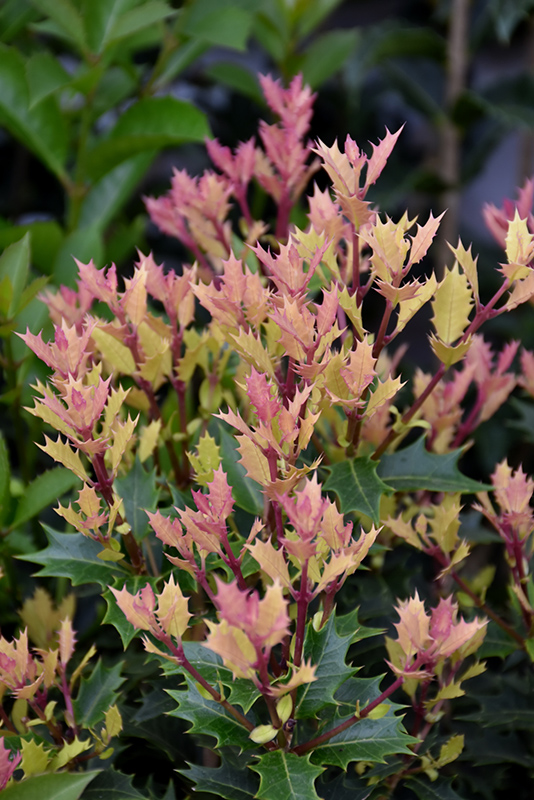Height: 5 feet Spread: 3 feet
Sunlight:
Hardiness Zone: 6a Other Names: Tea Olive, Olive Holly, Holly-Leaf Osmanthus Brand: Star Roses and Plants Description: This compact cultivar is similar in looks to holly, but it's actually related to lilac and privet; bright pink and white new foliage matures to olive green; flowers may not be showy but are extremely fragrant, blooming in fall; more adaptable than holly Ornamental Features Party Lights™ False Holly has attractive dark green foliage with pointy light green spines which emerges pink in spring on a plant with an oval habit of growth. The spiny pointy leaves are highly ornamental and remain dark green throughout the winter. It features subtle fragrant white flowers along the branches in mid fall. The smooth khaki (brownish-green) bark and burgundy branches are extremely showy and add significant winter interest. Landscape Attributes Party Lights™ False Holly is a dense multi-stemmed evergreen shrub with a shapely oval form. Its average texture blends into the landscape, but can be balanced by one or two finer or coarser trees or shrubs for an effective composition. This is a relatively low maintenance shrub, and is best pruned in late winter once the threat of extreme cold has passed. Gardeners should be aware of the following characteristic(s) that may warrant special consideration; Party Lights™ False Holly is recommended for the following landscape applications; Planting & Growing Party Lights™ False Holly will grow to be about 5 feet tall at maturity, with a spread of 3 feet. It has a low canopy, and is suitable for planting under power lines. It grows at a slow rate, and under ideal conditions can be expected to live for 40 years or more. This shrub does best in full sun to partial shade. It prefers to grow in average to moist conditions, and shouldn't be allowed to dry out. It is not particular as to soil type or pH. It is highly tolerant of urban pollution and will even thrive in inner city environments. This is a selected variety of a species not originally from North America.![]()
![]()
![]()
![]()
![]()
![]()
![]()
![]()
![]()
![]()
![]()
![]()
![]()
martha@rainfrostnursery.com
| 2452 Bethel Church Rd, Forest, VA 24551
Call us Today! (434) 525-3107
NetPS
Plant Finder
Characteristics
Applications
Features & Attributes
Phone:
(434) 525-3107 |
Email:
martha@rainfrostnursery.com |
Fax: 434-525-2062
Address: 2452 Bethel Church Rd, Forest, VA 24551
Business Hours:
Retail Nursery Hours are 9 to 5 Monday through Sat. | Closed Sundays




Content, including images, displayed on this website is protected by copyright laws. Downloading, republication, retransmission or reproduction of content on this website is strictly prohibited. Terms of Use
| Privacy Policy


